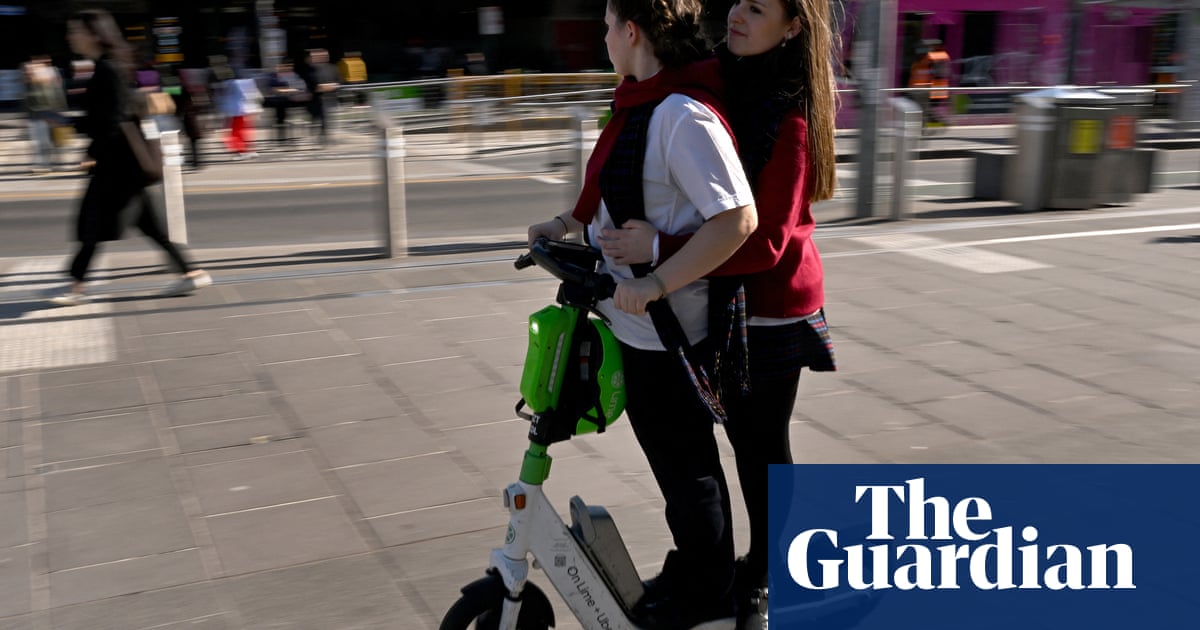Every three days, a child injured on an e-scooter would come through the emergency department doors at the Sunshine Coast university hospital, according to Dr Matthew Clanfield.
Between 2023 and 2024,176 children were treated at the Queensland hospital.
Some got off lucky with a scuffed knee. Others suffered life-threatening brain injuries requiring neurosurgery and psychological care.
Clanfield’s analysis of these injuries in under-16s treated at the hospital have beenpublished in the Australian and New Zealand Journal of Public Health. It is the first data in Australia to capture paediatric e-scooter injuries, and it’s “only the tip of the iceberg”, Clanfield said.
Analysing paediatric ED triage notes, the ages of those injured ranged between five and 15 years old. One in 10 had life-threatening or potentially life-threatening injuries, and more than a third suffered at least one bone fracture.
Based on self-reported data from the patients, at the time of the accidents, 42% of children were not wearing a helmet; 36% were exceeding the legal speed limit of 25 kilometres an hour for e-scooters on Queensland roads; and in 13% of cases two people were riding one scooter.
Sign up for Guardian Australia’s breaking news email
“We had one child who got up to 70 kilometres an hour on an e-scooter and T-boned a car,” Clanfield said.
In May, the Crisafulli LNP governmentannounced a parliamentary inquiryinto e-bike and e-scooter safety, but Clanfield’s study has called for “immediate governmental action” raising the age limit to protect children and match other states.
In Queensland, children aged 12 to 15 are allowed to ride e-scooters if they are supervised by an adult riding alongside them on another device. Queensland and the Australian Capital Territory are the only jurisdictions that allow 12-year-olds to legally ride e-scooters.
In New South Wales, Victoria, Western Australia and Tasmania e-scooter users must be aged at least 16. The age limit is 18 in the Northern Territory and South Australia, according to Assoc Prof Terry Slevin, the CEO of the Public Health Association of Australia.
E-scooter accidents are a “growing problem”, Slevin said. But a lack of national data to identify the size of the problem and no nationally consistent rules or enforcement of those laws make it a difficult problem to solve, he said.
A University of Melbourne researcher, Assoc Prof Milad Haghani, searched local news stories published between January 2020 and April 2025 to gather data on e-scooter related deaths. He identified 30 fatalities. Of those, 11 were aged under 18.
Slevin said a serious problem was that children did not have a sophisticated understanding of the road rules or road safety.
However, he said e-scooters were also a “general community safety issue” because other road, footpath and cycle path users could be struck by e-scooters.Dr Sarah Whitelaw, the Australian Medical Association’s federal emergency medicine representative, said the study reflected what was happening in other states and territories.
Whitelaw said it was “heartbreaking” when injured patients and their families said “they had no idea that they could get so badly injured on an e-scooter”.“Emergency care and trauma specialists right around Australia are increasingly concerned about the number of injuries that we’re seeing with regards to children under 18,” she said.Children were “massively over-represented” in cases of e-scooter injuries and deaths, despite e-scooters being mostly ridden by adults.Part of the problem, Whitelaw said, was that “these devices are unfortunately marketed to kids … [and] it’s not clear to parents that, in fact, in many states and territories, it’s illegal to ride them outside your home on public property unless you’re over 16”.
She said rather than banning e-scooters, governments should improve safety laws.
